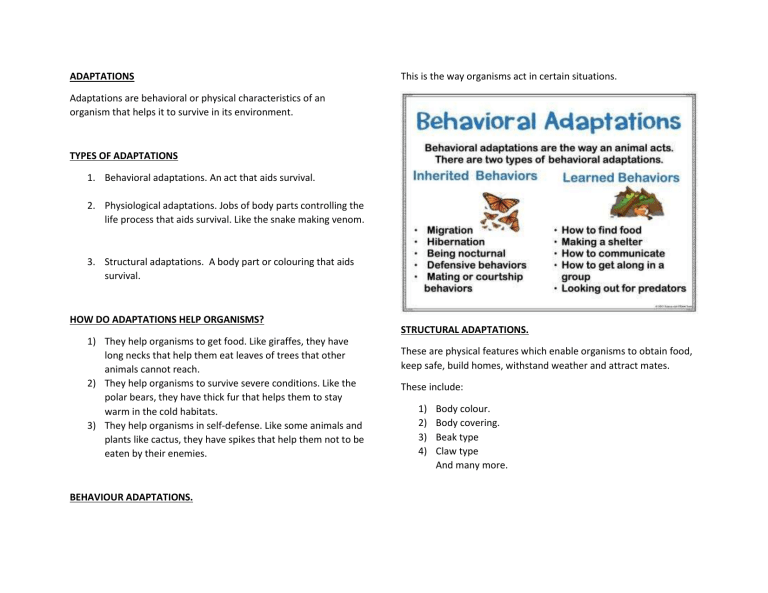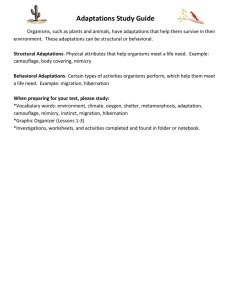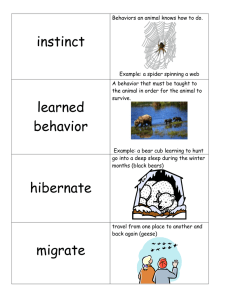
ADAPTATIONS This is the way organisms act in certain situations. Adaptations are behavioral or physical characteristics of an organism that helps it to survive in its environment. TYPES OF ADAPTATIONS 1. Behavioral adaptations. An act that aids survival. 2. Physiological adaptations. Jobs of body parts controlling the life process that aids survival. Like the snake making venom. 3. Structural adaptations. A body part or colouring that aids survival. HOW DO ADAPTATIONS HELP ORGANISMS? 1) They help organisms to get food. Like giraffes, they have long necks that help them eat leaves of trees that other animals cannot reach. 2) They help organisms to survive severe conditions. Like the polar bears, they have thick fur that helps them to stay warm in the cold habitats. 3) They help organisms in self-defense. Like some animals and plants like cactus, they have spikes that help them not to be eaten by their enemies. BEHAVIOUR ADAPTATIONS. STRUCTURAL ADAPTATIONS. These are physical features which enable organisms to obtain food, keep safe, build homes, withstand weather and attract mates. These include: 1) 2) 3) 4) Body colour. Body covering. Beak type Claw type And many more. ACTIVITY: 4) …………………………………………………………………………………………… ……………………………………………………………………………………………. ADAPTATIONS OF A GIRAFFE 1) …………………………………………………………………………………………… …………………………………………………………………………………………… 2) …………………………………………………………………………………………… ……………………………………………………………………………………………. 3) …………………………………………………………………………………………… …………………………………………………………………………………………… ADAPTATIONS OF FISH: CAMOUFLAGE: These are colours, pattern or shape of body parts of an animal that allows it to blend in with its surroundings. This helps animals to hide from their enemies and to find their food. HABITAT ADAPTATIONS Organisms need to adapt to their habitats to survive. Habitats are different so organisms living in different habitats need different adaptations to survive. WAYS OF HABITAT ADAPTATIONS 1) 2) 3) 4) Camouflage. Mimicry Migration Hibernation. MIMICRY; This is the type of animal adaptation that allows an animal to look like another kind of animal. It helps animals from being eaten by their enemies and to get food. Some butterflies have large spots on their wings that resemble the eyes of an owl. This scares away the birds from eating them. Some animals behave like other animals like some harmless snakes have the same body patterns like those of dangerous snakes. This protects them from birds. MIGRATION This when animals move to another habitat due to habitat changes. HIBERNATION This is when animals go into deep sleep through the winter. They need little or no food during hibernation. Some animals like emperor penguins gather together in the cold to keep warm.



